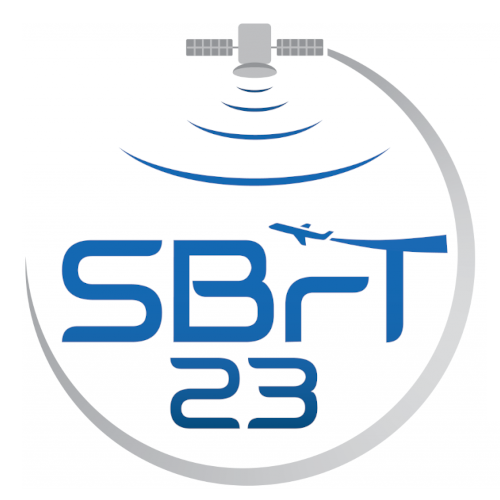
XLI Simpósio Brasileiro de Telecomunicações e Processamento de Sinais
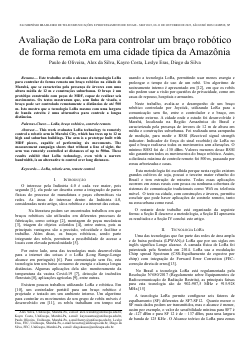
Avaliação de LoRa para controlar um braço robótico de forma remota em uma cidade típica da Amazônia
Leslye Castro Eras, Diego Silva, Alex Silva, Kayro Costa, Paulo de Oliveira
DOI: 10.14209/sbrt.2023.1570916101
Keywords: LoRa Braço robótico Controle remoto
Abstract
This work evaluates LoRa technology to remotely control a robotic arm in Marabá City, which has wooded areas with trees up to 12 m high and suburban buildings. The arm is a prototype built with MDF pieces, capable of performing eight movements. The measurement campaign shows that without a line of sight, the arm was remotely controlled at distances of up to 500m. These results exhibit that LoRa technology, even with a narrow bandwidth, is a great alternative to control over long distances.Download
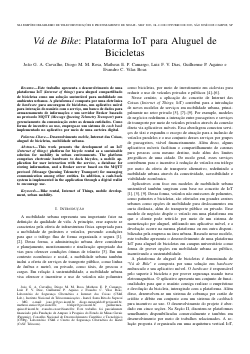
Vá de Bike: Plataforma IoT para Aluguel de Bicicletas
João Gabriel Azevedo Carvalho, Diogo Menegaldo Maioli Rosa, Matheus Enrico Perroni Camargo, Guilherme Pedro Aquino, Evandro Cesar Vilas Boas
DOI: 10.14209/sbrt.2023.1570916139
Keywords: Desenvolvimento mobile Internet das Coisas Aluguel de bicicletas Mobilidade Urbana
Abstract
Esse trabalho apresenta o desenvolvimento de uma plataforma IoT (Internet of things) para aluguel compartilhado de bicicletas como uma solução sustentável para mobilidade em ambientes urbanos. A plataforma é composta por uma eletrônica de hardware necessária para ancoragem de bicicletas, um aplicativo móvel para interação do usuário com o serviço, um banco de dados para armazenamento de informações e um servidor Broker baseado no protocolo MQTT (Message Queuing Telemetry Transport) para gerenciamento da comunicação entre as demais entidades. Como forma de incentivo ao uso, emprega-se um sistema de cash back implementado no aplicativo por meio de uma carteira digital.Download
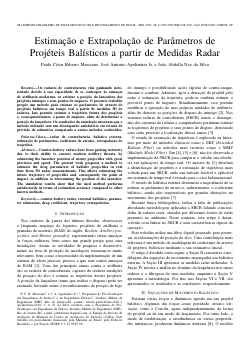
Estimação e Extrapolação de Parâmetros de Projéteis Balísticos a partir de Medidas Radar
Paulo César Ribeiro Marciano, José Antonio Apolinário Jr., João Abdalla Ney da Silva
DOI: 10.14209/sbrt.2023.1570916184
Keywords:
Abstract
Counter-battery radars have been gaining notoriety due to their ability to counter modern artillery threats, by estimating the launcher position of enemy projectiles with great precision and speed. The present work proposes a real-time method for estimating ballistic projectile drag parameters based on 3D measurements of radars. A method for the extrapolation of these parameters and estimation of the future trajectory is presented, allowing prediction of the point of impact (IPP) and estimation of the launcher position through radar measurements with restricted time intervals.Download
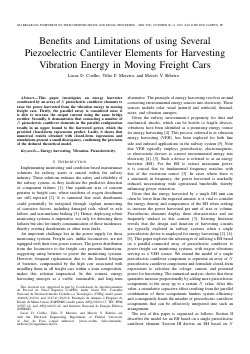
Benefits and Limitations of using Several Piezoelectric Cantilever Elements for Harvesting Vibration Energy in Moving Freight Cars
Lucas Coelho, Túlio F. Moreira, Moises Vidal Ribeiro
DOI: 10.14209/sbrt.2023.1570916396
Keywords: Energy harvesting. Vibration. Piezoelectricity.
Abstract
This paper investigates an energy harvester constituted by an array of N cantilever piezoelectric elements to raise the power harvested from the vibration energy in moving freight cars. Firstly, the parallel array is considered since it is able to increase the output current using the same bridge rectifier. Secondly, it demonstrates that connecting a number of N piezoelectric cantilever elements in the parallel configuration results in an upper bound to the harvested power, which the provided closed-form expressions predict. Lastly, it shows that numerical results obtained with closed-form expressions and simulations present a small discrepancy, confirming the precision of the deduced theoretical model.Download
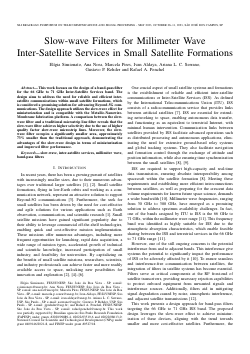
Slow-wave Filters for Millimeter Wave Inter-Satellite Services in Small Satellite Formations
Elígia Simionato, Ana Júlia N Francisco, Marcela Pires de Souza, Ivan Aldaya, Ariana Serrano, Gustavo P. Rehder, Rafael Abrantes Penchel
DOI: 10.14209/sbrt.2023.1570916461
Keywords: slow-wave inter-satellite services millimeter wave band-pass filters
Abstract
This work focuses on the design of a band-pass filter for the 66 GHz to 71 GHz Inter-Satellite Services band. The design aims to address the need for reliable and efficient inter-satellite communications within small satellite formations, which is considered a promising solution for advancing Beyond-5G communications. The design approach utilizes the slow-wave effect for miniaturization and is compatible with the Metallic-Nanowire-Membrane fabrication platform. A comparison between the slow-wave filter and a traditional microstrip line filter reveals that the slow-wave filter achieves higher selectivity due to the use of higher quality factor slow-wave microstrip lines. Moreover, the slow-wave filter occupies a significantly smaller area, approximately 73% smaller than the traditional approach, demonstrating the advantages of the slow-wave design in terms of miniaturization and improved filter performance.Download
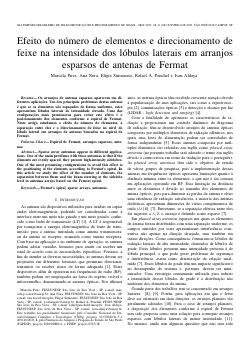
Efeito do número de elementos e direcionamento de feixe na intensidade dos lóbulos secundários em arranjos esparsos de antenas de Fermat
Marcela Pires de Souza, Ana Júlia N Francisco, Elígia Simionato, Rafael Abrantes Penchel, Ivan Aldaya
DOI: 10.14209/sbrt.2023.1570916593
Keywords: Espiral de Fermat Arranjos esparsos Antenas
Abstract
Os arranjos de antenas esparsos aparecem em diferentes aplicações. Um dos principais problemas destas antenas é que se os elementos são espaçados de forma uniforme, estes apresentam lóbulos laterais de intensidade elevada. Uma das configurações mais promissoras para evitar este efeito é o posicionamento dos elementos conforme a espiral de Fermat. Neste artigo estudamos o efeito do número de elementos, a separação entre eles e o direcionamento de feixe no nível do lóbulo lateral em arranjos de antenas baseados na espiral de Fermat.Download
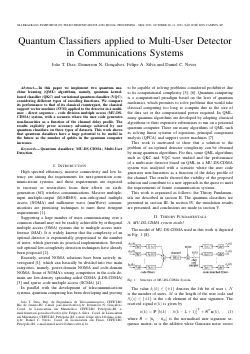
Quantum Classifiers applied to Multi-User Detector in Communications Systems
João T Dias, Demerson Gonçalves, Felipe de Almeida Silva, Daniel C Neves
DOI: 10.14209/sbrt.2023.1570916643
Keywords: Quantum classifiers MU-DS-CDMA Multi-User Detection
Abstract
In this paper we implement two quantum machine learning (QML) algorithms, namely, kernel-based classifier (QKC) and variational quantum classifier (VQC), considering different types of encoding functions. We compare its performance to that of its classical counterpart, the classical support vector machine (SVM) applied to the multi-user detector in a MU-DS-CDMA system, with a scenario where the user code generates non-linearities as a function of the channel delay profile. The results explicitly prove accuracy advantage achieved by our quantum classifiers on three types of datasets. This work shows that quantum classifiers have a huge potential to be useful in the future as the number of qubits in the quantum computer increases.Download
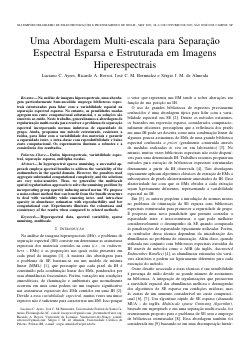
Uma Abordagem Multi-escala para Separação Espectral Esparsa e Estruturada em Imagens Hiperespectrais
Luciano Carvalho Ayres, Ricardo Augusto Borsoi, Jose Carlos Moreira Bermudez, Sérgio José Melo de Almeida
DOI: 10.14209/sbrt.2023.1570916644
Keywords: dados hiperespectrais variabilidade espectral estruturas de endmembers separação esparsa
Abstract
In hyperspectral sparse unmixing, a successful approach employs spectral bundles to address the variability of the endmembers in the spatial domain. However, the penalties used aggregate substantial computational complexity, and the solutions are very noise-sensitive. Thus, we generalize the multiscale spatial regularization approach to solve the unmixing problem by incorporating group sparsity inducing mixed norms. We propose a noise-robust method that can benefit from the bundle structure to deal with variability while ensuring inter- and intra-class sparsity in abundance estimation with reproducibility and low computational cost. Experiments illustrate the robustness and consistency of the results when compared to related methods.Download
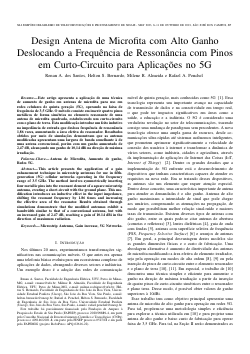
Design Antena de Microfita com Alto Ganho Deslocando a Frequência de Ressonância com Pinos em Curto-Circuito para Aplicações no 5G
Renan Santos, Helton Silva Bernardo, Milene Rodrigues Almeida, Rafael Abrantes Penchel
DOI: 10.14209/sbrt.2023.1570916723
Keywords: Antena de microfita Antena alto ganho Pinos em Curto- Circuito Antenas 5G
Abstract
Este artigo apresenta a aplicação de uma técnica de aumento de ganho em antenas de microfita para uso em redes celulares de quinta geração (5G), operando na faixa de frequência de 3,5 GHz. O método consiste em inserir quatro pinos metálicos de forma simétrica no elemento ressonante de uma antena de microfita quadrada, estabelecendo um curto-circuito com o plano de terra. Esta modificação introduz um feito indutivo na impedância de entrada que desloca frequência de ressonância 1,86 vezes, aumentando a área efetiva do ressonador. Resultados obtidos por meio de simulações demonstram que as antenas modificadas apresentam uma largura de banda semelhante à de uma antena convencional, porém com um ganho aumentado de 2,47 dB, alcançando um ganho de 10,14 dBi na direção de máxima irradiação.Download
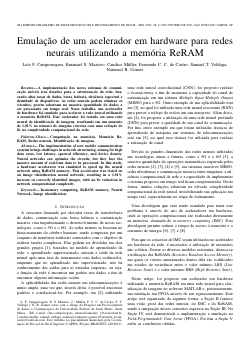
Emulação de um acelerador em hardware para redes neurais utilizando a memória ReRAM
Luis Felipe Camponogara, Emanuel Savegnago Maziero, Candice Muller, Fernando de Castro, Samuel Tumelero Valduga, Natanael Gomes
DOI: 10.14209/sbrt.2023.1570916779
Keywords: In-memory computing ReRAM memory Neural Network Image identification
Abstract
The implementation of new mobile communication systems brings challenges in network structuring, aiming for high data rates, low latency, spectral efficiency, and device density. Neural networks can optimize the circuits, but they face the massive amount of real-time data to be processed. In this study, a hardware accelerator was emulated to speed up the neural network using ReRAM memory. This accelerator was tested on an image identification neural network, resulting in a 1.01% increase in correctly identified images, with an 8x reduction in network computational complexity.Download